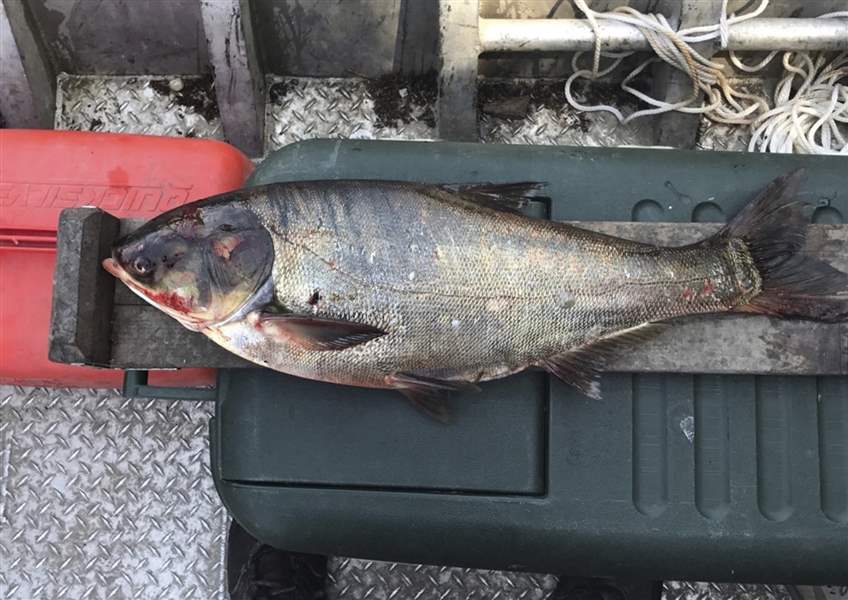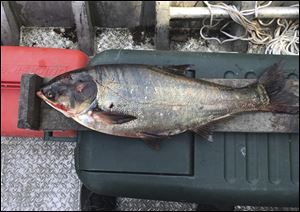
Young, old, Democrat or Republican: Great Lakes residents hate Asian carp
9/28/2018
A silver carp that was caught in the Illinois Waterway below T.J. O'Brien Lock and Dam, approximately nine miles away from Lake Michigan.
ASSOCIATED PRESS
If there’s one thing people in the Great Lakes region seem united about in these politically divisive times, it’s their hatred of Asian carp.
A new poll shows more than 90 percent of residents in Ohio, Michigan, Illinois, Indiana, and Wisconsin want the federal government to form a stronger blockade in the Chicago area to keep northerly migrating silver and bighead Asian carp from getting into Lake Michigan via Illinois rivers.

A silver carp that was caught in the Illinois Waterway below T.J. O'Brien Lock and Dam, approximately nine miles away from Lake Michigan.
Another take-home message: More than 7 of every 10 of those polled support a “fair share” concept promoted by Michigan Gov. Rick Snyder to help fund ongoing operations and additional security measures at the Brandon Road Lock and Dam southwest of Chicago, near Joliet, Ill., which the U.S. Army Corps of Engineers now sees as its best hope for a shutoff point. Those costs are estimated at $8 million a year.
Under Mr. Snyder’s plan, future funding would be weighted on the length of the Great Lakes shoreline.
Michigan, which has by far the most, would pay more than half of the ongoing operations and maintenance of additional security improvements eyed for that lock and dam. It is not known how much Ohio, which has the second most, would pay. Illinois, which has relatively little shoreline, would be asked to contribute 2 percent. Mr. Snyder’s plan also calls for Michigan to help any of the other states pay if they can’t come up with their share.
“The poll results clearly demonstrate that Great Lakes residents understand that the time to act on Asian carp is now,” Mr. Snyder said in a news release.
Ohio, Michigan, Wisconsin, the city of Chicago, and the province of Ontario came together earlier this year to form what’s known as the Block Asian Carp partnership, an effort that grew out of the frustration over the national government’s response throughout the past three decades. Block Asian Carp commissioned the poll, considered a first of its kind.
Two years ago, the issue had languished on for so long that several Great Lakes charter boat captains held a news conference to warn about the dangers of complacency from what they called Asian carp “fatigue.”
In December, 26 members of Congress — including U.S. Reps. Marcy Kaptur (D., Toledo), Bob Latta (R., Bowling Green), Tim Walberg (R., Tipton), and Debbie Dingell (D., Dearborn) — joined numerous other elected officials in demanding more aggressive action from the U.S. Army Corps of Engineers.
All stated in a bipartisan letter they are firmly holding the Corps to an early 2019 deadline for completing the most crucial report for a long-term fix, called the Brandon Road Lock & Dam Study. That letter mirrors one submitted earlier by several U.S. senators from the Great Lakes area, including Rob Portman (R., Ohio) and Debbie Stabenow (D., Mich.), co-chairs of the Senate Great Lakes Task Force, and U.S. Sen. Sherrod Brown (D., Ohio), U.S. Sen. Gary Peters (D., Mich.), and senators from Minnesota, Wisconsin, Illinois, and New York who are members of that task force.
During a teleconference with reporters on Tuesday, Michigan Department of Natural Resources Director Keith Creagh amplified the Snyder administration’s call for more aggressive action.
“What we're really talking about here is risk reduction,” Tammy Newcomb, Michigan DNR senior water policy adviser, said about the decision to fortify the Brandon Road Lock and Dam.
The poll found no major differences between party lines or other demographics, such as age. It was an online survey done by a national research firm Qualtrics, from Aug. 22 to Sept. 8, and is based on more than 3,000 responses.
Bighead Asian carp can grow to 110 pounds. Silver Asian carp can become like fleshy projectiles — leaping from the water whenever boats are present. They are the two most notorious of four fish species commonly called Asian carp, and the two which have wreaked the most havoc on the ecology of streams they inhabit.
Both are voracious eaters. Biologists fear they would eventually make their way over to western Lake Erie — the hub of the Great Lakes region’s $7 billion fishery — and destroy the food chain that supports native fish such as walleye and yellow perch.
“Regardless where you live in the Great Lakes and whether you identify yourself as a Democrat or Republican, people know more needs to be done about Asian carp,” said Molly Flanagan, vice president for policy at the Chicago-based Alliance for the Great Lakes.
Contact Tom Henry at thenry@theblade.com, 419-724-6079, or via Twitter @ecowriterohio.